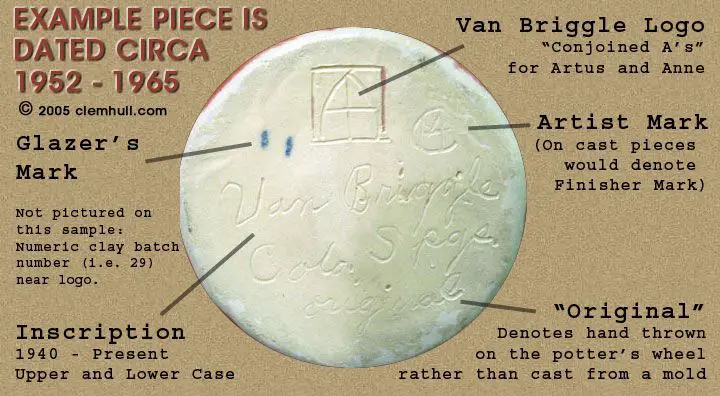How Do I Identify My Pottery Makers Mark?
Identifying marks on pottery pieces can provide crucial information about their history and value. Pottery marks indicate details about the origin, artist, manufacturer, and approximate date of pieces. Knowing how to inspect and research these marks is an important skill for antique collectors, auction houses, museums, and anyone interested in learning about the story behind their pottery.
Marks serve as a fingerprint, tracing a piece back to its roots. They allow appraisers, dealers, and collectors to authenticate antique pottery and determine its significance. The mark can make the difference between an average ceramic and a rare, prized artifact. By learning to decipher the meanings hidden within pottery marks, you can unlock fascinating details that bring new life to your collection.
Look on the Bottom
Pottery marks are most often found on the bottom of pieces. This is the most convenient place for potters to put identifying marks without marring the visibility or design of the pottery. Marks are typically stamped or impressed on the bottom, though they may also be glazed, printed, etched, engraved, or inscribed into the clay or glaze. Check the very bottom center of the piece, as well as around the edges of the base. Look carefully, as marks can be faint or partially worn off over time.
Some common locations to check include:
- Dead center of the bottom
- Recessed center of the foot ring
- Edge of the bottom near maker’s mark
- On the angled side of the base
Being methodical about checking the entire bottom surface will help locate any identifying maker’s marks.
Understand Different Mark Formats
There are several main types of marks that can be found on the bottom of pottery pieces:
-
Impressed or incuse marks are created by pressing a design into the soft clay before firing. This creates a recessed mark.
-
Incised marks are thinly carved into the clay surface.
-
Stamped marks are created by inked stamps pressed into the clay.
-
Printed marks apply colored pigments onto the clay surface.
-
Painted marks are hand-painted designs or signatures.
-
Stickers and paper labels may be affixed to the bottom.
Understanding the main types of marks can help narrow down the search when trying to identify a maker’s mark. Look closely at the characteristics of the mark to determine if it is impressed, stamped, printed, etc. This provides clues about how and when it was applied.
Use Resources to Identify Marks
There are several resources available to help identify pottery marks including reference books, websites, databases, and expert services. Here are some options to consider:
Books like Kovels’ New Dictionary of Marks, The Dictionary of British Pottery and Porcelain Marks, and Warman’s Antiques & Collectibles Price Guide offer comprehensive catalogs of pottery marks from major manufacturers. The pros of using reference books are that they provide detailed information and can be handy while antiquing. The cons are that print books can become outdated and don’t have the convenience of digital search.
Online databases such as Antique Marks, Replacements.com, and the Digital Fire Museum allow you to search marks and get information about date, origin, and maker. The benefit of websites is accessibility, but some charge fees or subscriptions for full access.
Expert services like appraisers, antiques dealers, collectors groups, and auction houses can also assist with identifying marks. They offer personalized guidance, but can be expensive and time consuming.
A combined approach of using books, websites, and experts as needed may be the most effective route for identifying mysterious pottery marks.
Look for Letters, Numbers, Symbols
Pottery marks often contain letters, numbers, and symbols that provide clues to help identify the maker. Here are some common elements to look for:
Initials – Many marks include the initials of the potter, artist, or company. Matching initials to known potters can help authenticate the piece.
Dates – Numbers like 1820 or 03/05/1895 can indicate when the piece was made. Dates help narrow down the possible makers. Pottery Marks Identification Guide.
Logos – Logos are usually a combination of text and images like an insignia, monogram, or brand mascot. Recognizable logos make marks easier to identify. A manual of marks on pottery and porcelain.
Shapes – Geometric shapes like circles, diamonds, stars, and squares are common in marks. Symbol dictionaries can decode their meanings.
Look closely at all letters, numbers, and symbols in the mark. Compare them to resources like initials lists, logo databases, symbol guides, and date references to unlock clues. With some detective work, esoteric marks can reveal their origins.
Identify Location of Origin
The location of origin for a piece of pottery can sometimes be identified from elements of the maker’s mark. There are certain distinguishing characteristics between marks from different countries or regions:
- British pottery marks often include the word “England” or “Made in England.” Marks may also include a simplified image of a crown or coat of arms, indicating royal warrant holders approved to supply the royal family.
- Chinese pottery marks frequently contain Chinese characters indicating the dynasty or reign mark of the emperor during which the piece was produced. Some also include thespecific location of production in China.
- German pottery marks tend to include place names like Meissen, Heinrich, or Bavaria which refer to cities or regions where the pottery was made. Many also include “Germany” or “Made in Germany.”
- Japanese marks often have the potter’s name in stylized Japanese characters as well as the location of the studio, such as Seto, Izumo, or Bizen.
- Native American pottery marks and signatures are unique to tribes and pueblos. Distinctive designs and motifs can identify the geographic location.
These identifying elements provide clues about where the pottery originated before being widely distributed. Understanding the meanings behind the marks allows collectors to authenticate the source location for their pottery.
Sources:
Research the Pottery Maker

Once you have identified the mark on your piece of pottery, the next step is to research the history and background of the pottery maker or company. This can provide useful context on the time period your item was produced as well as the styles and techniques used.
A good place to start researching pottery companies is The Marks Project, which has an extensive dictionary of American studio pottery marks from 1946 to the present. Simply search for the name of the maker and you can find details on when they were active, their influences and styles, as well as examples of marked work.
For older and more established pottery companies, look for reference books on makers’ marks that cover major porcelain and pottery manufacturers through history. These will provide key facts about locations, operating dates, and signature styles. Local historical societies and museums focused on pottery are also great resources.
Online auction records can also assist with identifying the typical era a mark was used. Just Art Pottery recommends checking completed eBay listings to find comparable marked pieces and when they were produced.
Researching the pottery maker using the mark as a starting point allows you to get the full story behind your ceramic piece and appreciate its origins.
Authenticate the Mark
It is important to authenticate marks, especially on high value pieces, to ensure they are genuine and not fakes. There has been a proliferation of fake marks used to increase the perceived value of pieces. According to pottery-english.com, buyers should be wary of “pseudo-marks” that imitate real marks but denote inferior quality.
One method to authenticate marks is using scientific analysis. Techniques like thermoluminescence dating and spectrometric analysis can verify the age and composition of ceramic pieces as described on chinese-antique-porcelain.com. Consult an expert appraiser or auction house to arrange testing for extremely valuable items.
Buyers should be cautious of any suspicious details that suggest a fake mark, such as uneven stamping, inaccurate styles for the time period, or marks not recorded in databases. When in doubt, seek a second opinion from a reputable appraiser before making high-value purchases.
Determine Approximate Age
One way to determine the approximate age of a piece of pottery is by looking for any dates, logos, or technologies used that can provide clues. Many pottery makers started adding date marks to their pieces in the early 20th century. For example, pieces made by Wedgwood after 1908 will have the date included in the mark. Some German potteries also started adding date cyphers to marks in the early 1900s. If you see “RD” followed by some numbers, that is a German date mark. The RD stands for “Reichs-Dekret” and the numbers indicate the year made. For example, RD84 would mean made in 1884.
Some clues about age can also come from logos and technologies used. The presence of a certain logo style or format can indicate a particular era that a company used it. Or if a piece has a backstamp made with impressed lettering, that technique points to an earlier time period before screen-printed stamps became common. Understanding the evolution of technologies and production methods for pottery can provide good hints about age.
Get Help from Experts
If you’ve exhausted other options and are still uncertain about identifying a pottery maker’s mark, it’s recommended to consult an antique appraiser. Appraisers are experts at assessing the history and value of antiques, including pottery.
The appraisal process typically involves the appraiser physically examining the pottery piece to authenticate the mark. They will also assess the age, condition, rarity, and other attributes to determine the approximate value. This provides helpful information for insurance purposes or if you are considering selling the pottery.
According to Dr. Lori, factors appraisers consider include the artist’s reputation, comparable sales data, materials used, and overall demand in the current market. An appraisal provides peace of mind about your pottery’s history and an estimate of its monetary value.




